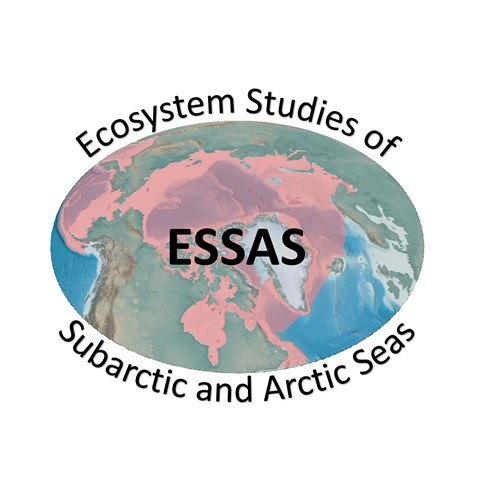The goal of the ESSAS Program is to compare, quantify and predict the impact of climate variability on the productivity and sustainability of Subarctic and Arctic marine ecosystems.
Since its acceptance as a GLOBEC Regional Program in 2005, ESSAS has been active sponsoring many scientific workshops and meetings.They began the program with an Open Science Meeting (OSM) in May 2005, hosted by PICES in Victoria, Canada that focused on Climate Variability and Sub-Arctic Marine Ecosystems by examining past and ongoing studies of the effects of climate variability in the Subarctic seas. One of its purposes was to provide a guidepost of where we were at in terms of our knowledge of Subarctic marine ecosystems. In 2009, with the ending of GLOBEC, ESSAS joined IMBER (Integrating Marine Biogeochemistry and Ecosystem Research). In May of 2011, ESSAS held its second OSM in Seattle, USA on Comparative studies of climate effects on polar and subpolar ocean ecosystems: progress in observation and prediction. With increasing interest in the Arctic and pressure on for IMBER presence there, ESSAS began to include studies on the interaction between the Subarctic and the Arctic. In 2015, they officially changed their name to the Ecosystem Studies of Subarctic and Arctic Seas to reflect their expanded geographic scope. In June 2017, ESSAS held its latest OSM in Tromsø, Norway that was entitled Moving in, out and across the Subarctic and Arctic marine ecosystems: shifting boundaries of water, ice, flora, fauna, people and institutions. In addition, ESSAS has also sponsored an Annual Science Meeting (ASM) containing one to three workshops on subjects ranging on a variety of topics related to the climate and its ecological effects.
Much of the work of ESSAS is carried out in Working Groups. These are of limited duration and tackle specific objectives through sponsored workshops at the ASMs and/or generate science initiatives. There are also national and multinational programs, some of which have included extensive field programs. Major programs have included those in Japan, China (via IPY), the United States, Iceland, and Norway, and collaborative international programs between Canada and Norway (NORCAN), the U.S. and Norway (MENU, MENUII, NUCCME) and Japan, U.S. and Norway (RACArctic). ESSAS was the lead organization of the International Polar Year (IPY) consortium, Ecosystem Studies of Subarctic and Arctic Regions (ESSAR). ESSAS has sponsored or co-sponsored several theme sessions and symposia with PICES and ICES at their annual Science conferences. There are also ESSAS-endorsed research projects. The ESSAS program is overseen by a Scientific Steering Committee (SSC) that includes members from Canada, Greenland, Iceland, Japan, Korea, Norway, Russia, and the United States.
Working Groups
ESSAS presently has four Working Groups. These sponsor annual workshops and generate science initiatives. They include:
Working Group 1 on Regional Climate Prediction: The goal of Working Group 1 is to provide quantitative estimates of the magnitude and uncertainty of future climate change for the ESSAS regions, and the frequency distribution of natural variability
Working Group 2 on Biophysical Coupling: The goal of Working Group 2 is to determine how climate-driven variability in physical conditions and processes in the ocean will affect the organisms that make up marine ecosystems and thus the transfer of energy and material through sub-arctic marine ecosystems.
Working Group 3 on Modeling Ecosystem Response: The goal of Working Group 3 is to develop conceptual, mechanistic/process, statistical/empirical, and simulation models to facilitate comparison of ESSAS ecosystems and to forecast the impacts of climate change on ecosystem structure and function in multiple ESSAS ecosystems.
Working Group 4 on Gadoid – Crustacean Interactions: The goal of Working Group 4 is to assess the effects of ocean climate variation and fishing on the interactions between gadoid fishes and crustaceans by conducting a comparative study across multiple sub-arctic marine ecosystems.
National and International Programs
In addition to the four Working Groups, ESSAS is affiliated with national programs, many of which include extensive field programs, in Japan, China (via IPY), the United States, Iceland, and Norway, and collaborative international programs between Canada and Norway (NORCAN) and the U.S. and Norway (MENU, MENUII). ESSAS is also the lead organization of the International Polar Year (IPY) consortium, Ecosystem Studies of Subarctic and Arctic Regions (ESSAR). ESSAS has sponsored or co-sponsored theme sessions and symposia with PICES, and through its affiliated program, Marine Ecosystems of Norway and the US (MENU), sponsored a full day Theme Session at the ICES Annual Science Meeting in Helsinki that resulted in a special volume of Progress in Oceanography with 16 papers. Countries with members on the ESSAS SSC include Korea, Japan, Russia, the United States, Canada, Iceland, Norway, and Denmark.











